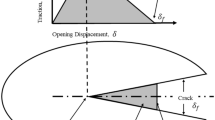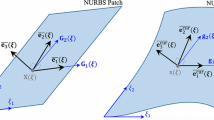Abstract
Analysing the collapse of skin-stiffened structures requires capturing the critical phenomenon of skin-stiffener separation, which can be considered analogous to interlaminar cracking. This paper presents the development of a numerical approach for simulating the propagation of interlaminar cracks in composite structures. A degradation methodology was introduced in MSC.Marc, which involved the modelling of a structure with shell layers connected by user-defined multiple-point constraints (MPCs). User subroutines were written that employ the virtual crack closure technique (VCCT) to determine the onset of crack growth and modify the properties of the user-defined MPCs to simulate crack propagation. Methodologies for the release of failing MPCs are presented and are discussed with reference to the VCCT assumption of self-similar crack growth. The numerical results obtained by using the release methodologies are then compared with experimental data for a double-cantilever beam specimen. Based on this comparison, recommendations for the future development of the degradation model are made, especially with reference to developing an approach for the collapse analysis of fuselage-representative structures.
Similar content being viewed by others
References
R. Degenhardt, R. Rolfes, R. Zimmerman and K. Rohwer, “COCOMAT — Improved MATerial Exploitation at Safe Design of COmposite Airframe Structures by Accurate Simulation of COllapse,” Comp. Struct., 73, 178–178 (2006).
COCOMAT Home Page, www.cocomat.de (2006).
T. K. O’Brien, “Characterization of delamination onset and growth in a composite laminate,” in: Damage in Composite Materials, ASTM STP 775 (1982), pp. 140–167.
T. K. O’Brien, “Interlaminar fracture toughness: The long and winding road to standardization,” Composites, B, 29, 57–62 (1998).
E. F. Rybicki and M. F. Kanninen, “A finite element calculation of stress intensity factors by a modified crack closure integral,” Eng. Fract. Mech., 9, 931–938 (1977).
R. Krüger, M. König, and T. Schneider, “Computation of local energy release rates along straight and curved delamination fronts of unidirectionally laminated DCB-and ENF-specimens,” in: Proc. of the 34th AIAA/ASME/ASCE/AHS/ASC SSDM Conf., La Jolla, CA, AIAA Washington (1993), pp. 1332–1342.
J. Li, S. M. Lee, E. W. Lee, and T. K. O’Brien, “Evaluation of the edge crack torsion ECT Test for mode III interlaminar fracture toughness of laminated composites,” J. Comp. Technol. Res., 19, 174–183 (1997).
M. M. A. Wahab, “On the use of fracture mechanics in designing a single lap adhesive joint,” J. Adhes. Sci. Technol., 19, 851–865 (2000).
M. Qin and Y. Dzenis, “Nonlinear numerical and experimental analysis of single lap adhesive composite joints with delaminated adherends,” in: Y. Zhang (ed.), Proc. of the 13th Int. Conf. on Composite Materials (ICCM13), Beijing (2001).
J. T. Wang and I. S. Raju, “Strain energy release rate formulae for skin-stiffener debond modeled with plate elements,” Eng. Fract. Mech., 54, 211–228 (1996).
J. Li, T. K. O’Brien, and C. Q. Rousseau, “Test and analysis of composite hat stringer pull-off test specimens,” J. Amer. Heli. Soc., 350–357 (1997).
W. S. Johnson, L. M. Butkus, and R. V. Valentin, Applications of Fracture Mechanics to the Durability of Bonded Composite Joints, U.S. Department of Transportation, Federal Aviation Administration DOT/FAA/AR-97/56 (1998).
R. Krueger, The Virtual Crack Closure Technique: History, Approach, and Applications, NASA/CR-2002-211628, ICASE Virginia, USA (2002).
P. P. Camanho and C. G. Davila, Mixed-Mode Decohesion Finite Elements for the Simulation of Delamination in Composite Materials, NASA/TM-2002-211737, NASA Langley Research Center, Virginia, USA (2002).
Y. Mi, M. A. Crisfield and G. A. O. Davies, “Progressive delamination using interface elements,” J. Compos. Mater., 32, No. 14, 1246–1272 (1998).
A. C. Orifici, R. S. Thomson, R. Degenhardt, C. Bisagni, and J. Bayandor, “Development of a degradation model for the collapse analysis of composite aerospace structures,” in: C. A. Mota Soares et al. (eds), Proc. of the 3rd Europ. Conf. on Computational Mechanics: Solids, Structures and Coupled Problems in Engineering, Lisbon, Portugal, 5–9 June (2006).
J. W. H. Yap, R. S. Thomson, M. L. Scott, and D. Hachenberg, “Influence of post-buckling behaviour of composite stiffened panels on the damage criticality,” Comp. Struct., 66, 197–206 (2004).
MSC.Marc and MSC.Mentat User Manuals Version 2005, MSC.Software Corporation, Santa Ana, CA (2004).
G. R. Irwin, “Fracture I,” in: Flügge (ed.), Handbook der Physik (1958), pp. 558–590.
B. D. Davidson, “An analytical investigation of delamination front curvature in double cantilever beam specimens,” J. Compos. Mater., 24, 1124–1137 (1990).
A. J. Brunner, “Experimental aspects of Mode I and Mode II fracture toughness testing of fibre-reinforced polymer-matrix composites,” Comput. Meth. Appl. Mech. Eng., 185, 161–172 (2000).
A. Kling and R. Degenhardt, Characterization of Material Properties, Results of the EU Project COCOMAT, Internal DLR Report, IB 131-2006/18 (April, 2006).
Determination of Interlaminar Fracture Toughness Energy-Mode I-G Ic . European Normative Standard DIN EN 6033, Deutsches Institut für Normung, e. V. (1996).
Author information
Authors and Affiliations
Additional information
Russian translation published in Mekhanika Kompozitnykh Materialov, Vol. 43, No. 1, pp. 15–42, January–February, 2007.
Rights and permissions
About this article
Cite this article
Orifici, A.C., Thomson, R.S., Degenhardt, R. et al. Development of a finite-element analysis methodology for the propagation of delaminations in composite structures. Mech Compos Mater 43, 9–28 (2007). https://doi.org/10.1007/s11029-007-0002-6
Received:
Issue Date:
DOI: https://doi.org/10.1007/s11029-007-0002-6




